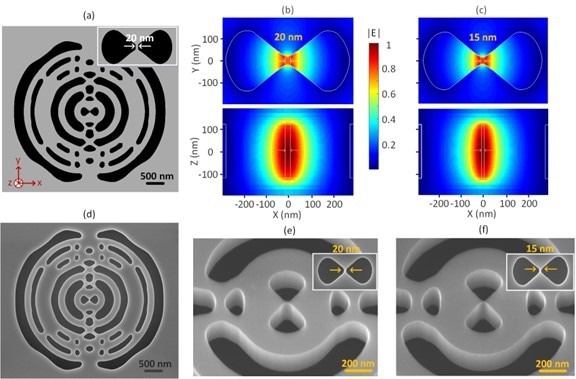New gadgets that enhance the interaction between photons and electrons and integrate electrical and photonic functions at the nanoscale are needed as humans enter a new age of computing. Researchers have created a novel III-V semiconductor nanocavity that restricts light at levels below the so-called diffraction limit, which is a significant step toward meeting this goal.
 Researchers developed a new III-V semiconductor nanocavity that confines light at levels below the diffraction limit. The design of the cavity is shown in a, the calculated electric field distribution in b and c, and scanning electron microscopy images in d-f. Image Credit: Meng Xiong, Technical University of Denmark
Researchers developed a new III-V semiconductor nanocavity that confines light at levels below the diffraction limit. The design of the cavity is shown in a, the calculated electric field distribution in b and c, and scanning electron microscopy images in d-f. Image Credit: Meng Xiong, Technical University of Denmark
Nanocavities with ultrasmall mode volumes hold great promise for improving a wide range of photonic devices and technologies, from lasers and LEDs to quantum communication and sensing, while also opening up possibilities in emerging fields such as quantum computing. For example, light sources based on these nanocavities could significantly improve communication by enabling faster data transmission and strongly reduced energy consumption.
Meng Xiong, Academic Technician, Department of Electrical and Photonics Engineering, Quantum and Laser Photonics, Technical University of Denmark
In the journal Optical Materials Express, the researchers demonstrate that their novel nanocavity has a mode volume that is an order of magnitude lower than previously shown in III-V materials. III-V semiconductors possess distinct features that make them appropriate for optoelectronic devices.
The significant spatial confinement of light exhibited in this work improves light-matter interaction, allowing for larger LED powers, lower laser thresholds, and higher single-photon efficiency.
Xiong added, “Light sources based on these new nanocavities could have a major impact on data centers and computers, where ohmic and power-hungry connections could be replaced by high-speed and low-energy optical links. They could also be used in advanced imaging techniques such as super-resolution microscopy to enable better disease detection and treatment monitoring or to improve sensors for various applications, including environmental monitoring, food safety and security.”
Boosting Light Interaction
The research is being conducted by scientists at the NanoPhoton - Center for Nanophotonics at the Technical University of Denmark. They aim to investigate a novel class of dielectric optical cavities that allow for deep subwavelength light confinement by using a concept they named extreme dielectric confinement (EDC).
EDC cavities might result in extremely efficient computers with deep-subwavelength lasers and photodetectors integrated into transistors for lower energy consumption by improving the interaction between light and matter.
In the current study, an EDC cavity in the III-V semiconductor indium phosphide (InP) was initially built by the researchers using a methodical mathematical technique that relaxed geometric limitations and optimized the topology. They then used dry etching and electron beam lithography to build the structure.
“EDC nanocavities have feature sizes down to a few nanometers, which is crucial for achieving extreme light concentration, but they also come with a significant sensitivity to fabrication variations. We attribute successful realization of the cavity to the improved accuracy of the InP fabrication platform, which is based on electron beam lithography followed by dry etching,” Xiong added.
Making a Smaller Nanocavity
The second phase of topological optimization was based on the researchers' achievement of a relatively tiny dielectric feature size of 20 nm, which they attained through refinement of the fabrication method. After one last optimization cycle, the nanocavity’s mode volume was just 0.26 (λ/2n)³, where λ is the light’s wavelength and n is its refractive index.
This accomplishment is four times smaller than what is commonly referred to as a nanocavity’s diffraction-limited volume, which is equivalent to a light box with a side-length half of the wavelength.
The researchers note that while silicon has recently produced cavities with similar characteristics, III-V semiconductors have direct band-to-band transitions, which silicon does not. These transitions are necessary to utilize the Purcell enhancement that nanocavities give.
Xiong concluded, “Prior to our work, it was uncertain whether similar outcomes could be achieved in III-V semiconductors because they don't benefit from the advanced fabrication techniques developed for the silicon electronics industry.”
Currently, the researchers are attempting to decrease the mode volume further by increasing manufacturing accuracy. To create a useful nanolaser or nanoLED, they also want to employ the EDC cavities.
Journal Reference:
Xiong, M., et. al. (2024) Experimental realization of deep sub-wavelength confinement of light in a topology-optimized InP nanocavity. Optical Materials Express. doi:10.1364/OME.513625.